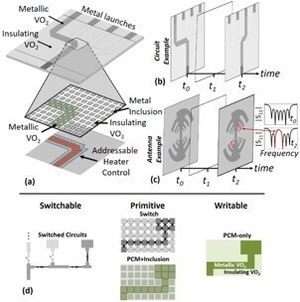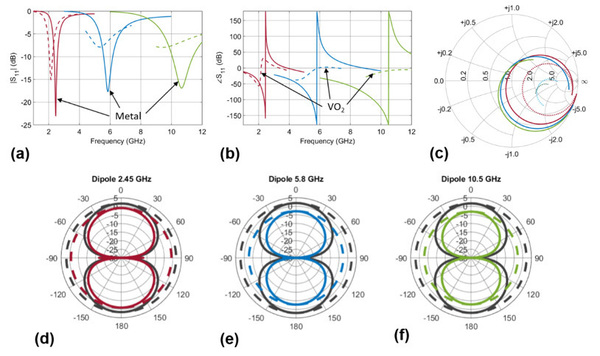Dynamically Reconfigurable RF Circuits and Antennas

We have developed a concept for dynamically reconfigurable distributed microwave circuits by leveraging the abrupt conductivity transition in phase-change materials (PCM). Metallic surface-inclusions are embedded in the PCM film—vanadium dioxide (VO2)—to provide low-loss and reconfigurability. To enable engineering design we have developed a circuit model and a full-wave electromagnetic model validated with measurements up to 50 GHz. The circuit model is well-suited for high-speed transmission-line based reconfigurable RF circuit design while the EM model is accurate for transmission-line structures, antennas, and any other 3D structure. Loss can be maintained below a dB for structures on the order of a wavelength (e.g, matching networks, tuners, hybrids, etc.) down to a few GHz and of much larger structures up to about 50 GHz. The concept requires a control mechanism which could be either a 2D addressable heater array (depicted at right), or a raster-scanned IR or UV laser, or even a digital-mirror-device (DMD). It is important to emphasize that without the metallic inclusions VO2 in the “metallic” state is more like a NiCr film (conductivity of 1E5 S/m) and exhibits prohibitively high losses. Only by including a large percentage of metal in each unit-cell can the losses be brought low enough to render programmable circuits feasible.
Applications:
Several demonstration circuits have been designed including wideband impedance tuners able to access all regions of the Smith chart with high |Γ|, wideband impedance tunable antennas with extremely wide bandwidth (more than a decade), and switch matrices for many-to-many interconnections where the complexity of a traditional switch-based approach is prohibitive. The VO2-metal surface-inclusion dipole shown below is tunable from 2.45 to 10.5 GHz (wider ranges are easily possible by extending the VO2 region at the end of the dipole). VO2 dipoles exhibit nearly identical radiation patterns to ideal metallic dipoles with, in general, about 30% radiation efficiency which is acceptable in many applications given the added benefit of extremely wide tunability (here a 4.25 tuning ratio). The triple stub tuner is able to cover nearly the entire Smith chart with a very high maximum reflection, | Γ|=0.84/0.93 (open/short). It also operates over extremely wide bandwidths (here we show 5-40 GHz) which makes this tuner broadly applicable.



Relevant Publications:
D. Connelly and J. Chisum, “VO2 antennas with metallic inclusions for low-loss reconfigurable cognitive radios," in Microw. Opt. Techn. Lett., https://onlinelibrary.wiley.com/doi/10.1002/mop.32729.
D. Connelly and J. Chisum, “Dynamically Reconfigurable Microwave Circuits Leveraging Abrupt Phase-Change Material,” in IEEE Trans. Microw. Theory Techn., Aug. 6, 2020, https://ieeexplore.ieee.org/document/9161288
N. Estes and J. Chisum, “Increased Power Handling of Vanadium Dioxide T/R Switches Using a ResonantTopology,” in Proc. 2019 IEEE MTT-S Intl. Microw. Symp. (IMS), Boston MA, Jun. 2-7, 2019. https://ieeexplore.ieee.org/abstract/document/8701088